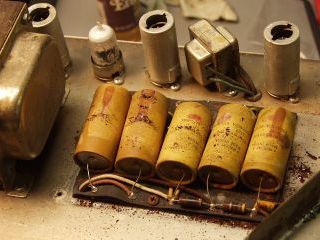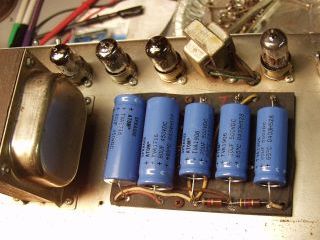| Home |
| About Us |
| Amplifiers |
| Repair |
| Contact |

Amplifier Restoration
and Repair
Do you have an aging guitar or bass amplifier that needs some tender, loving care? Do you need to be sure that it will perform on or off the road for many years to come? We have the experience, the know-how, and the skill required to restore your vacuum-tube based instrument amplifier to as-new condition, whether it be a recent reissue, or a gem from the '50s. If you are the owner of an older instrument amplifier -- whether a "closet classic" in great cosmetic condition, or a tired, beat-to-death amp fallen from grace, we'll do what's necessary to bring it back to top performing condition.
- 50-plus years (!) experience with Tube Audio and Instrument Amplifiers
- Fender Certified Electronics Service Technician
- Quality Rebuilds of Hand-wired Electronics, chassis, and cabinets
- True-to-Period Component Replacement
- Loudspeaker recommendations and installation
- NOS or Highest Quality New Vacuum Tubes
- Proper bias setting
- Tone optimization, hum and noise reduction
- Electronic and Physical Stress Testing
Typical restoration jobs require
- New electrolytic filter capacitors
- New electrolytic cathode bypass capacitors
- Reconditioning or replacement of input jacks and panel controls
- Installation of 3-wire grounded plug/cord for safety and reduced hum
- Cleaning - dust and dirt removed from inside cabinet, speaker baffle, knobs, switches and chassis
- Speaker replacement if original is torn or damaged
- Speaker grille cloth replaced if severely torn or missing
 |
 |
Power supply filter caps restored in 1966 Fender Super Reverb Amp
We are very conservative when it comes to replacing components. We only replace components that have obviously deteriorated over time or are near end-of-life and jeopardizing the overall health of the amplifier. Obviously, vacuum tubes are the most visible components that deteriorate with time and use, and require periodic changing. They were the original "user replacable part", commonly serviced by the user in the past. Today's selection of tubes is more varied and complex than in the past. Instead of three or four reliable manufacturers as we had in the decades through the 70s, we now have a dozen or so of varying quality scattered around the world. We can help you select the high-quality and reliable choice for your tubes.
1960s Fender Princeton Amp upgrade: New electrolytic capacitors, 3-wire grounded A-C cord/plug, general cleanup:
(caption)
Another example of components that deteriorate over time are carbon composition resistors. They can introduce noise, change the amplifier's gain, and send bias currents into dangerous territory. Examples of components that might be near end-of-life are filter capacitors. These can operate fine for many years and then fail catastrophically. We generally recommend that electrolytics manufactured in the '50s and '60s should be replaced with high quality parts, as most are approaching the end of their safe operating lives.
Input jacks seldom wear out, but they do show signs of wear after years
of plugging and unplugging guitar cords. Their chromed surfaces wear
off where the plug makes contact, exposing the brass they are made of.
When the brass oxidizes, a poor connection results, and the connection
is prone to noise that gets amplified into loud crackles and pops. Much
of this noise can be remedied by applying a small amount of a good
contact cleaning solution. High quality
replacement jacks are available and can be used to replace the
originals if cleaning doesn't eliminate the problem.
Home | About Us | Amplifiers | Repair | Contact
Hamilton-Kolby Custom Electronics
Acton, Massachusetts, USA
Hamilton-Kolby.com

Copyright © 2021 Hamilton-Kolby Custom Electronics
